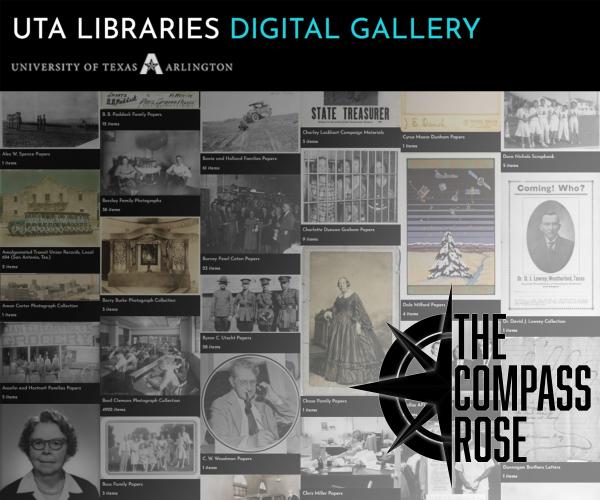
by Sara Pezzoni


by Sara Pezzoni
The purpose of The Compass Rose is to raise awareness of Special Collections' resources and to foster the use of these resources. The blog series also reports significant new programs, initiatives, and acquisitions of Special Collections.
This blog post is the second in our new "How To" series focused on using online resources to find Special Collections material.
This week’s blog gives an overview of how to search the UTA Libraries Digital Gallery. The Digital Gallery is an online collection of digital objects that provides access to the unique and valuable holdings of UTA Special Collections. Items uploaded to the Digital Gallery are digitized versions of our collection materials, ranging from photographic prints and negatives to maps, manuscript materials, sheet music, original artworks, postcards, and many different types of ephemera.
Items uploaded to the Digital Gallery were produced by digitization programs in both the Special Collections and the Digital Creation Departments. These departments operate mostly on a scan-on-demand model, stemming mostly from research requests and grant-funded projects. These departments also digitize items for preservation purposes or projects where staff members seek to highlight specific events in history to share on social media, blogs, or in physical exhibits.
Once an item is digitized, metadata is then created to describe the item and help users locate materials in the Digital Gallery. There are many different components to consider when describing an item. For each item on the Digital Gallery, we assign a unique identifier number, title, description, creation date, categories, subject headings, collection name, Special Collections identifier/call number, and rights/licensing information.
There are a few different ways to begin your search for materials in the Digital Gallery. From the homepage, you can start by entering keywords to the search bar (seen at upper right side of the page). In using the search bar, it is best to use quotes if you are using more than one search term; for example, searching Frontier Fiesta (without quotes) will pull every record with the word “Frontier” or “Fiesta,” not necessarily the two together. Searching “Frontier Fiesta” in quotes will pull all records with the word “Frontier” and the word “Fiesta” included in the title or description. Another way to begin your search is to use the “Browse” feature. The “Browse” button (see Figure 1) can be seen to the right of the search bar, and once clicked, three links will appear to see All Items (displays all items uploaded to the Digital Gallery), Categories (groupings of items based on a specific topic/theme), and Collections (includes a list of collections from which the images on the Digital Gallery came).
Once you enter your keyword(s) in the search bar or start your search by using the “Browse” feature, you will be taken to a results page that features a section of "limiters" on the left side of the page (see Figure 2). These limiters will help you refine your search results by collection, location, category, decade, and various subject terms. There is also a date range slider if you’re searching for materials created in a specific year or a range of years.
Let's run a sample search: you’re looking for photos relating to the Texas Rangers baseball team from the 1980s and 1990s that are in the Fort Worth Star-Telegram collection. Here’s the search you can undertake:
Here is another sample search: you’re looking for photos of parades taken in Breckenridge, Texas from the 1930s:
Once you’re able to find the image(s) you are looking for, each image will have its own page that will display information about the item (see Figure 3). This will include an identifier (unique to each item scanned), a title (brief description of the image), a description (more in-depth description of the image and any other relevant information), categories (topical/thematic descriptors), subjects (allows for navigation or cross-reference to other records in the Digital Gallery with the same assigned subject), the collection name (from which collection this image originates), a Special Collections identifier (location of where this item physically exists), and information about the rights/licenses that is assigned to that image. There is also a “Cite This Item” tab to the upper right side of the page and, once clicked, it displays citations for the image in APA, Chicago/Turabian, and MLA styles.
Another feature of the Digital Gallery includes the ability to view more information about each collection. After you have navigated to a collection’s page (all of which are accessible by either the Collections page or on each individual record under the “Collection” section in the metadata), you can click on a tab to the left side of the page titled “About” and this will display information about the collection, a link to the collection’s finding aid (if available), and collection identifiers (see Figure 4).
If you are looking for additional information about the Digital Gallery, to the right of the “Browse” button is a button that shows a circled lowercase “i” (see Figure 5) – once clicked, you will see links for an About page, which describes UTA Libraries’ mission and goals for the Digital Gallery and an overview of how the site is organized; an Acknowledgements page, which displays information about those who have contributed to the creation and maintenance of the Digital Gallery, as well as a list of grants UTA Libraries has received to digitize Special Collections’ materials and grow the Digital Gallery; and a Contact Us page, which leads to a form for users to complete and send to the administrators of the Digital Gallery with any questions/comments about the Digital Gallery.
UTA Libraries is committed to making our content accessible to everyone, including individuals with disabilities. We welcome your feedback to help us improve access to the Digital Gallery! Additionally, please let us know if an alternative format is needed for you to access print information and images online. You may use our Contact Us form to inquire about more options and to submit feedback.
The Digital Gallery is an ever-expanding work in progress! Have you searched the Digital Gallery and still need help or have a reference question? The staff of UTA Special Collections are always willing to assist, please reach out to us via email (spcoref@uta.edu) if you have any questions. The next few blogs in this series highlighting how to search TARO (Texas Archival Resources Online), Archive-It, and Wikipedia Commons will soon be published on The Compass Rose blog.
Add new comment